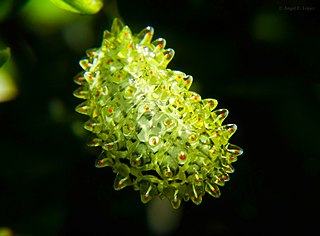
The Dalceridae are a small family of zygaenoid moths with some 80 known species encompassing about one dozen genera mostly found in the Neotropical region with a few reaching the far south of the Nearctic region.
Rectiostoma fernaldella is a species of moth in the family Depressariidae. It was described by Riley in 1889. It is found from southern Mexico to the United States, where it is found in the eastern basin and range area in southern Arizona and disjunctly to California. There is also a record for Tennessee.

Halysidota davisii, or Davis' tussock moth, is a species of moth in the family Erebidae. It was described by Henry Edwards in 1874. It is found in Utah, Arizona, New Mexico and north-western Texas.
Leucanopsis lurida is a moth of the family Erebidae. It was described by Henry Edwards in 1887. It is found in Colombia, Mexico and southern Arizona in the United States.
Pseudohemihyalea labecula, the freckled glassy-wing, is a moth in the family Erebidae. It was described by Augustus Radcliffe Grote in 1881. It is found in the United States in southern Nevada, Utah, from Colorado to Arizona, New Mexico and western Texas.

Acraga coa is a moth of the family Dalceridae. It is found in southern Mexico, Belize, Honduras, Guatemala, El Salvador, Costa Rica and Panama. The habitat consists of tropical wet, tropical moist, tropical premontane wet, tropical premontane rain, tropical lower montane moist, subtropical wet, subtropical moist, subtropical dry and warm temperate wet forests.
Acraga chicana is a moth of the family Dalceridae. It is found in southern Mexico. The habitat consists of subtropical moist forests.
Acraga leberna is a moth in the family Dalceridae. It was described by Herbert Druce in 1890. It is found in Panama, Colombia, Venezuela, Guyana, Suriname, French Guiana, Ecuador, northern Brazil, Peru and Bolivia.
Dalcerides alba is a moth in the family Dalceridae. It was described by Herbert Druce in 1887. It is found in southern Mexico, Guatemala, Honduras, Belize, Costa Rica, Panama, Colombia and Ecuador.
Dalcerides sofia is a moth in the family Dalceridae. It was described by Harrison Gray Dyar Jr. in 1910. It is found in southern Mexico, Guatemala, El Salvador, Nicaragua and Costa Rica. The habitat consists of tropical moist, tropical dry, tropical premontane wet, subtropical moist, subtropical dry and warm temperate wet forests.
Dalcerides dulciola is a moth in the family Dalceridae. It was described by Harrison Gray Dyar Jr. in 1914. It is found in southern Mexico, Costa Rica, Panama, northern Ecuador and northern Venezuela. The habitat consists of tropical wet, tropical moist, tropical premontane wet and tropical premontane rain forests.
Dalcerides mesoa is a moth in the family Dalceridae. It was described by Herbert Druce in 1887. It is found in southern Mexico, Guatemala, Costa Rica, Panama, Colombia, Venezuela and Ecuador.
Dalcerides nana is a moth in the family Dalceridae. It was described by Paul Dognin in 1920. It is found in southern Brazil. The habitat consists of subtropical wet and subtropical moist forests.
Dalcerides rebella is a moth in the family Dalceridae. It was described by Schaus in 1911. It is found in Costa Rica and Ecuador. The habitat consists of tropical wet and premontane wet forests.
Dalcerides bicolor is a moth in the family Dalceridae. It was described by Schaus in 1910. It is found in Costa Rica.
Dalcerides chirma is a moth in the family Dalceridae. It was described by Schaus in 1920. It is found in southern Mexico and Guatemala. The habitat consists of tropical moist and subtropical wet forests.
Dalcerides flavetta is a moth in the family Dalceridae. It was described by Schaus in 1905. It is found in Venezuela, Guyana, Suriname, French Guiana, Colombia, Ecuador, Peru, Bolivia and northern Brazil. The habitat consists of tropical wet, tropical moist, tropical premontane wet, tropical premontane moist, subtropical moist and tropical dry forests.
Paracraga argentea is a moth in the family Dalceridae. It was described by Schaus in 1910. It is found in Mexico, Honduras, Belize, Guatemala, El Salvador, Costa Rica and Panama. The habitat consists of tropical wet, tropical moist, tropical premontane wet, tropical premontane moist, subtropical wet subtropical moist forests.
Dalcerides radians is a moth in the family Dalceridae. It was described by Walter Hopp in 1921. It is found in southern Brazil. The habitat consists of subtropical wet, subtropical moist and warm temperate moist forests.
Chionodes hostis is a moth in the family Gelechiidae. It is found in North America, where it has been recorded from Utah, Arizona and New Mexico.


